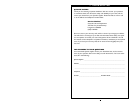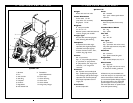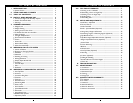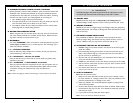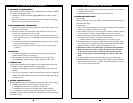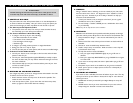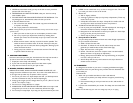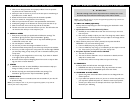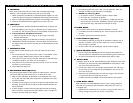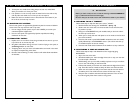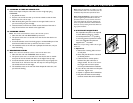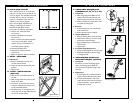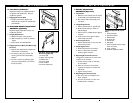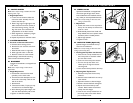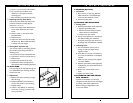
18
19
VII. WARNINGS: COMPONENTS & OPTIONS
D. FASTENERS
Many of the screws, bolts and nuts on this chair are special high-strength
fasteners. Use of improper fasteners may cause your chair to fail.
1. ONLY use fasteners provided by an authorized Quickie supplier (or ones
of the same type and strength, as indicated by the markings on the heads).
2. Over- or under-tightened fasteners may fail or cause damage to chair parts.
3. If bolts or screws become loose, tighten them as soon as you can.
E. FOOTRESTS
1. At the lowest point, footrests should be AT LEAST 21/2” off the ground.
If set too LOW, they may "hang up" on obstacles you can expect to find
in normal use. This may cause the chair to stop suddenly and tip forward.
2. To Avoid A Trip Or Fall When You Transfer:
a. Make sure your feet do not "hang up" or get caught in the space
between the footrests.
b. Avoid putting weight on the footrests, as the chair may tip forward.
3. NEVER lift this chair by the footrests. Footrests detach and will not bear
the weight of this chair. Lift this chair only by non-detachable parts of the
main frame.
F. PNEUMATIC TIRES
Proper inflation extends the life of your tires and makes your chair easier
to use.
1. Do not use this chair if any of the tires is under- or over-inflated. Check
weekly for proper inflation level, as listed on the tire sidewall.
2. Low pressure in a rear tire may cause the wheel lock on that side to slip
and allow the wheel to turn when you do not expect it.
3. Low pressure in any of the tires may cause the chair to veer to one side
and result in a loss of control.
4. Over-inflated tires may burst.
G. POSITIONING BELTS (Optional)
Use positioning belts ONLY to help support the rider's posture. Improper
use of these belts may cause severe injury to or death of the rider.
1. Make sure the rider does not slide down in the wheelchair seat. If this
occurs, the rider may suffer chest compression or suffocate due to pres-
sure from the belts.
2. The belts must be snug, but must not be so tight that they interfere with
breathing. You should be able to slide your open hand, flat, between the
belt and the rider.
3. A pelvic wedge or a similar device can help keep the rider from sliding
down in the seat. Consult with the rider's doctor, nurse or therapist to
find out if the rider needs such a device.
▲
!
VII. WARNINGS: COMPONENTS & OPTIONS
4. Use positioning belts only with a rider who can cooperate. Make sure
the rider can easily remove the belts in an emergency.
5. NEVER Use Positioning Belts:
a. As a patient restraint. A restraint requires a doctor's order.
b. On a rider who is comatose or agitated.
c. As a motor vehicle restraint. In an accident or sudden stop the rider
may be thrown from the chair. Wheelchair seat belts will not prevent
this, and further injury may result from the belts or straps.
H. POWER DRIVE
Do not install a power drive on any Quickie wheelchair. If you do:
1. It will affect the center of balance of your chair and may cause a fall or
tip-over.
2. It will alter the frame and void the warranty.
I. PUSH HANDLES (Optional)
1. Push handles provide secure points for an attendant to hold the rear of
this chair, to prevent a fall or tip-over. Make sure to use push handles
when you have an attendant.
2. Check to make sure push handle grips will not rotate or slip off.
J. QUICK-RELEASE AXLES
1. Do not use this chair UNLESS you are sure that both quick-release rear
axles are locked. An unlocked axle may come off during use and cause a fall.
2. An axle is not locked until the quick-release button pops out fully.
K. REAR AXLES
A change in set-up of the rear axles will affect the center of balance of your chair.
1. The farther you move the rear axles FORWARD, the more likely it is that
your chair will tip over backward.
2. Consult your doctor, nurse or therapist to find the best rear axle set-up
for your chair. Do not change the set-up UNLESS you are sure you are
not at risk to tip over.
3. Adjust the rear wheel locks after you make any change to the rear axles.
a. If you fail to do so, the locks may not work.
b. Make sure lock arms embed in tires at least 3/8 inch when locked.
L. REAR WHEEL LOCKS
Rear wheel locks are NOT designed to slow or stop a moving wheelchair.
Use them only to keep the rear wheels from rolling when your chair is at
a complete stop.
1. NEVER use rear wheel locks to try to slow or stop your chair when it is
moving. Doing so may cause you to veer out of control.
▲
!



